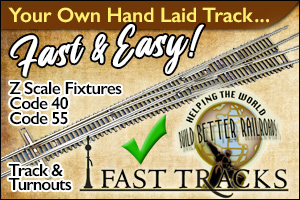Digital Command Control | DCC
 What Is DCC?
What Is DCC?
Digital Command Control (DCC) allows multiple model trains on the same section of track to operate independently of each other. Independent locomotive speed, direction and effects such as lighting are all possible through DCC.
Developed by Lenz of Germany for Marklin in the 1980s, Lenz donated the technology to the National Model Railroad Association (NMRA) to better its acceptance in the model railroad world. Companies like NCE, Train Control Systems (TCS), Model Rectifier Corp (MRC), Digitrax and others soon followed.
Each DCC system is physically different but consists of 4 key items:
- Command Station (the brains)
- Cab or Throttle (the hand-held control and display)
- Booster (for a larger layout, takes the Command Station data and boosts it to track power level)
- Decoder (purchased and installed separately for each locomotive, these accept digital instructions and in turn control the trains)
Under the DCC umbrella, there are NMRA standards and then there are vendor specific parameters. Every supplier abides by the adopted NRMA specifics and each supplier has their own specific operational features, which can then have their own specific parameters. Running your trains however on any DCC system, it all works together!
Let me say this first, to connect DCC to your existing track requires essentially nothing more than the same 2 wires that you currently use. That’s right, just remove your DC power pack, take the DCC system out of the box and connect the 2 track terminals to your existing wires, install a $30 decoder in your loco and run it!

DCC provides constant power to the track and uses digital addressing to send values to each locomotive (or accessory). Each loco has its own address. Since each loco has its own unique address, several locos can simultaneously be on the same track, each running at its own speed and direction! One very visible advantage of constant power applied to the track is constant lighting. No more varying lighting, and any loco (or car) on the track visually assures that it has pickup power.
Is It For Me?
If you have only one or maybe two locos on the track, DCC may not be necessary or desirable for you. If you have 2 main lines and want to run one around while you do switching off the other main, DCC may not be for you. However, if you have 2 or more locomotives and want to run them completely independently on the same or interconnected tracks, DCC is for you!
Why or how is DCC better than my plain DC power pack (or Joerger, Snail or Gaugemaster controllers?)
As you may have seen at train shows, multiple trains can be simultaneously run on the same track at different speed and in different directions. Have you ever tried to run two locomotives that run at different speeds with the exact same voltage using straight DC? It can be uneven at best. DCC doesn’t care! In a two locomotive setup just run the one locomotive at different speed steps than the other, as each locomotive has its own decoder to drive the motor. In DCC you can tweak each decoder’s values so that any loco runs the same speed as any other loco. Besides multiple trains on a single track, lighting effects can be changed, horns or bells activated, etc.
Since DCC always has power on the rails, it can more easily start your loco unlike a DC power pack, which takes say 1, 2 or 3 volts initially to begin moving. What also makes DCC better is BEMF (Back ElectroMotive Force), or let’s just say ‘feedback’, from the motor to compensate for any speed variations. This helps a loco get started from a stop or compensate for grades or dragging loads around a curve.
Some starter systems like NCE’s Power Cab have all the components in one-piece, known as the Cab, what you hold in your hand. Other systems can have the Command Station and Booster combined. Still, as mentioned earlier, there are just 2 wires to connect to the track.
As for the locomotives, a decoder must be installed. Any manufacturer’s decoder will work with any DCC system so you don’t have to worry about that. Decoders come in 2 types: “drop-in” and “wired”. Drop-in decoders are actually full circuit boards with a mounted decoder and are designed as direct circuit board replacements for specific locomotive chassis. Wired decoders mean you make the connections from the decoder to the loco’s original PC board, typically by soldering.
Micro-Trains Line GP-9 and GP-35, for example, use only the Digitrax DZ123M0 (that’s a zero on the end) whereas the Micro-Trains Line SD-40 uses Train Control Systems (TCS) MZ4A. American Z Lines locos use the TCS Z2 that must be wired in (essentially just 4-6 wires and well documented with clear pictures on TCS’s site).
What does it cost?
Starter sets, like NCE’s Power Cab are around $150 plus about $30 per loco decoder. MRC Prodigy Express costs about the same and the Digitrax Zephyr costs a bit more.
Where can I learn more?
http://www.ncedcc.com/images/stories/whatisdcc.pdf (Opens a PDF file)
http://ikm.digitrax.com/
https://sites.google.com/site/markgurries/ (http://tinyurl.com/6n83u7d)
http://www.nmra.org/standards/DCC/standards_rps/DCCStds.html
http://www.wiringfordcc.com/
Category: Introduction To Z Scale















